The Role of Knowledge in Competitive Advantage: MIS Essay
VerifiedAdded on 2023/06/03
|14
|4117
|165
Essay
AI Summary
This essay delves into the critical role of knowledge creation, sharing, and utilization in achieving and sustaining competitive advantage within the framework of Management Information Systems (MIS). Drawing upon the resource-based view, the essay examines how organizations can leverage their internal resources and capabilities, particularly knowledge management, to navigate the increasing turbulence of the external business environment. The discussion encompasses the importance of organizational learning, innovation, and dynamic capabilities in fostering resilience and adaptation. It further explores the interplay between explicit and tacit knowledge, emphasizing the significance of knowledge sharing mechanisms and a supportive organizational culture. The essay highlights the impact of these factors on product development, business model innovation, and overall organizational performance, ultimately arguing that effective knowledge management is central to achieving and maintaining a competitive edge in today's dynamic market landscape. The work refers to the work of Gupta and Dasgupta (2009) and other authors.
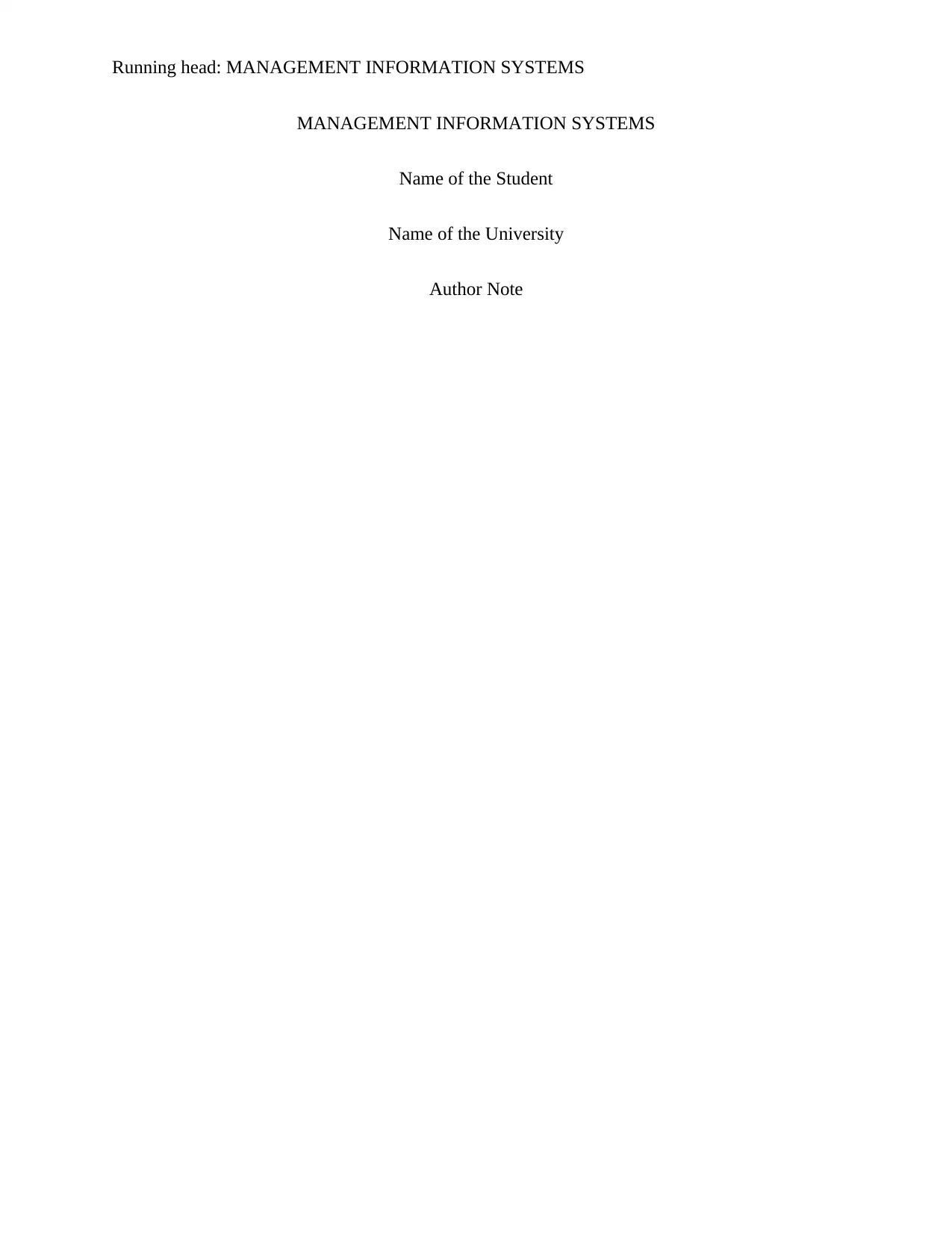
Running head: MANAGEMENT INFORMATION SYSTEMS
MANAGEMENT INFORMATION SYSTEMS
Name of the Student
Name of the University
Author Note
MANAGEMENT INFORMATION SYSTEMS
Name of the Student
Name of the University
Author Note
Paraphrase This Document
Need a fresh take? Get an instant paraphrase of this document with our AI Paraphraser
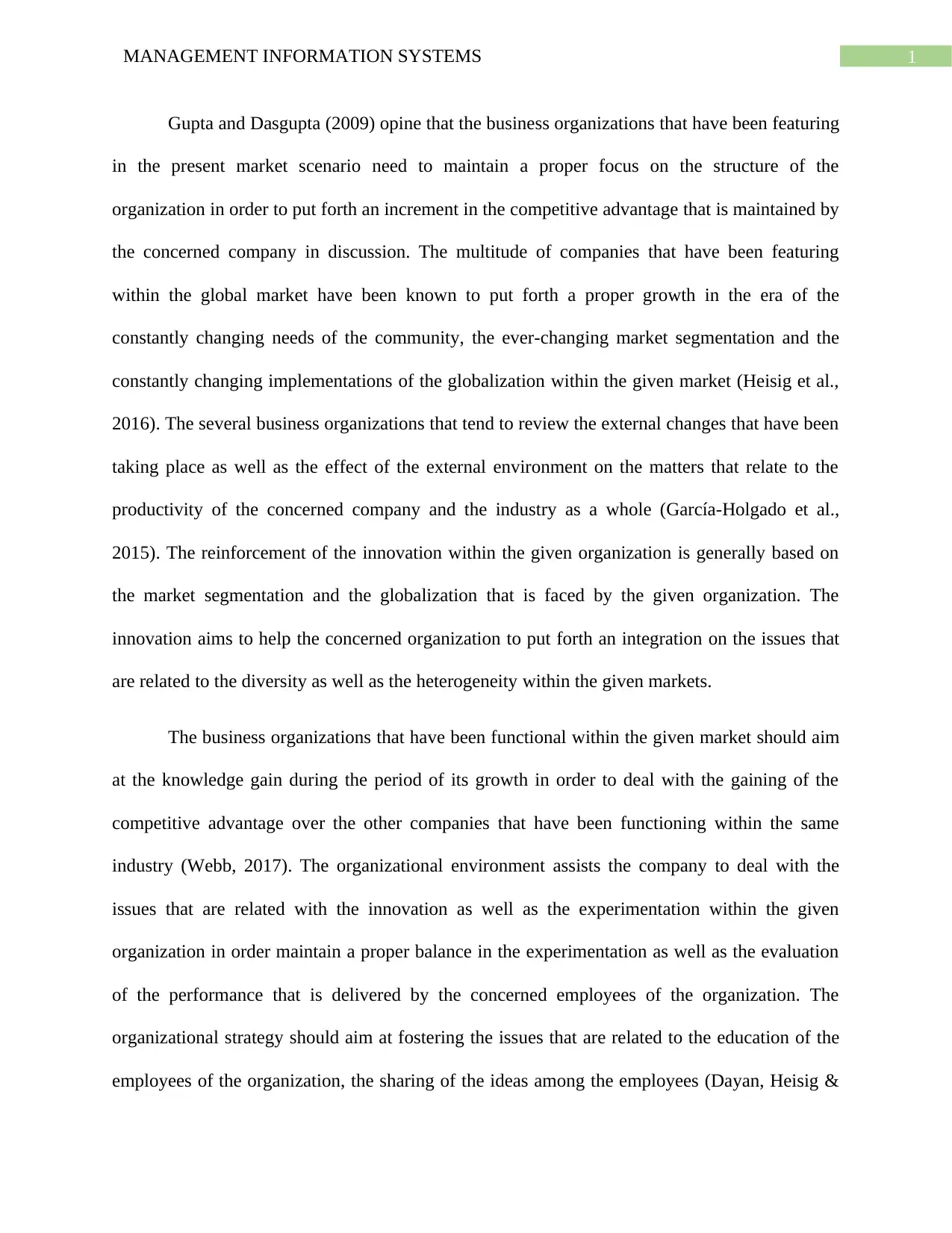
1MANAGEMENT INFORMATION SYSTEMS
Gupta and Dasgupta (2009) opine that the business organizations that have been featuring
in the present market scenario need to maintain a proper focus on the structure of the
organization in order to put forth an increment in the competitive advantage that is maintained by
the concerned company in discussion. The multitude of companies that have been featuring
within the global market have been known to put forth a proper growth in the era of the
constantly changing needs of the community, the ever-changing market segmentation and the
constantly changing implementations of the globalization within the given market (Heisig et al.,
2016). The several business organizations that tend to review the external changes that have been
taking place as well as the effect of the external environment on the matters that relate to the
productivity of the concerned company and the industry as a whole (García-Holgado et al.,
2015). The reinforcement of the innovation within the given organization is generally based on
the market segmentation and the globalization that is faced by the given organization. The
innovation aims to help the concerned organization to put forth an integration on the issues that
are related to the diversity as well as the heterogeneity within the given markets.
The business organizations that have been functional within the given market should aim
at the knowledge gain during the period of its growth in order to deal with the gaining of the
competitive advantage over the other companies that have been functioning within the same
industry (Webb, 2017). The organizational environment assists the company to deal with the
issues that are related with the innovation as well as the experimentation within the given
organization in order maintain a proper balance in the experimentation as well as the evaluation
of the performance that is delivered by the concerned employees of the organization. The
organizational strategy should aim at fostering the issues that are related to the education of the
employees of the organization, the sharing of the ideas among the employees (Dayan, Heisig &
Gupta and Dasgupta (2009) opine that the business organizations that have been featuring
in the present market scenario need to maintain a proper focus on the structure of the
organization in order to put forth an increment in the competitive advantage that is maintained by
the concerned company in discussion. The multitude of companies that have been featuring
within the global market have been known to put forth a proper growth in the era of the
constantly changing needs of the community, the ever-changing market segmentation and the
constantly changing implementations of the globalization within the given market (Heisig et al.,
2016). The several business organizations that tend to review the external changes that have been
taking place as well as the effect of the external environment on the matters that relate to the
productivity of the concerned company and the industry as a whole (García-Holgado et al.,
2015). The reinforcement of the innovation within the given organization is generally based on
the market segmentation and the globalization that is faced by the given organization. The
innovation aims to help the concerned organization to put forth an integration on the issues that
are related to the diversity as well as the heterogeneity within the given markets.
The business organizations that have been functional within the given market should aim
at the knowledge gain during the period of its growth in order to deal with the gaining of the
competitive advantage over the other companies that have been functioning within the same
industry (Webb, 2017). The organizational environment assists the company to deal with the
issues that are related with the innovation as well as the experimentation within the given
organization in order maintain a proper balance in the experimentation as well as the evaluation
of the performance that is delivered by the concerned employees of the organization. The
organizational strategy should aim at fostering the issues that are related to the education of the
employees of the organization, the sharing of the ideas among the employees (Dayan, Heisig &
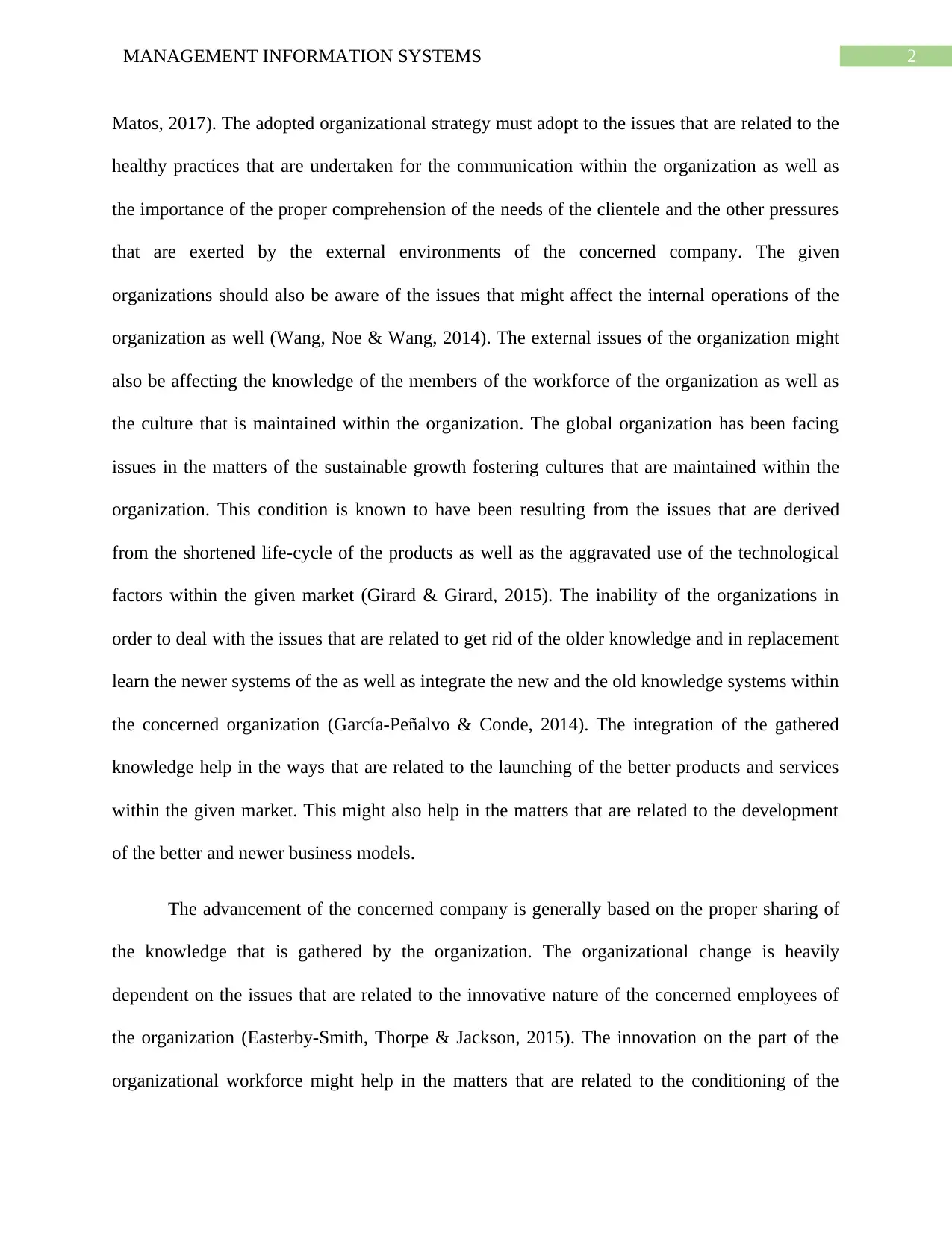
2MANAGEMENT INFORMATION SYSTEMS
Matos, 2017). The adopted organizational strategy must adopt to the issues that are related to the
healthy practices that are undertaken for the communication within the organization as well as
the importance of the proper comprehension of the needs of the clientele and the other pressures
that are exerted by the external environments of the concerned company. The given
organizations should also be aware of the issues that might affect the internal operations of the
organization as well (Wang, Noe & Wang, 2014). The external issues of the organization might
also be affecting the knowledge of the members of the workforce of the organization as well as
the culture that is maintained within the organization. The global organization has been facing
issues in the matters of the sustainable growth fostering cultures that are maintained within the
organization. This condition is known to have been resulting from the issues that are derived
from the shortened life-cycle of the products as well as the aggravated use of the technological
factors within the given market (Girard & Girard, 2015). The inability of the organizations in
order to deal with the issues that are related to get rid of the older knowledge and in replacement
learn the newer systems of the as well as integrate the new and the old knowledge systems within
the concerned organization (García-Peñalvo & Conde, 2014). The integration of the gathered
knowledge help in the ways that are related to the launching of the better products and services
within the given market. This might also help in the matters that are related to the development
of the better and newer business models.
The advancement of the concerned company is generally based on the proper sharing of
the knowledge that is gathered by the organization. The organizational change is heavily
dependent on the issues that are related to the innovative nature of the concerned employees of
the organization (Easterby-Smith, Thorpe & Jackson, 2015). The innovation on the part of the
organizational workforce might help in the matters that are related to the conditioning of the
Matos, 2017). The adopted organizational strategy must adopt to the issues that are related to the
healthy practices that are undertaken for the communication within the organization as well as
the importance of the proper comprehension of the needs of the clientele and the other pressures
that are exerted by the external environments of the concerned company. The given
organizations should also be aware of the issues that might affect the internal operations of the
organization as well (Wang, Noe & Wang, 2014). The external issues of the organization might
also be affecting the knowledge of the members of the workforce of the organization as well as
the culture that is maintained within the organization. The global organization has been facing
issues in the matters of the sustainable growth fostering cultures that are maintained within the
organization. This condition is known to have been resulting from the issues that are derived
from the shortened life-cycle of the products as well as the aggravated use of the technological
factors within the given market (Girard & Girard, 2015). The inability of the organizations in
order to deal with the issues that are related to get rid of the older knowledge and in replacement
learn the newer systems of the as well as integrate the new and the old knowledge systems within
the concerned organization (García-Peñalvo & Conde, 2014). The integration of the gathered
knowledge help in the ways that are related to the launching of the better products and services
within the given market. This might also help in the matters that are related to the development
of the better and newer business models.
The advancement of the concerned company is generally based on the proper sharing of
the knowledge that is gathered by the organization. The organizational change is heavily
dependent on the issues that are related to the innovative nature of the concerned employees of
the organization (Easterby-Smith, Thorpe & Jackson, 2015). The innovation on the part of the
organizational workforce might help in the matters that are related to the conditioning of the
⊘ This is a preview!⊘
Do you want full access?
Subscribe today to unlock all pages.

Trusted by 1+ million students worldwide
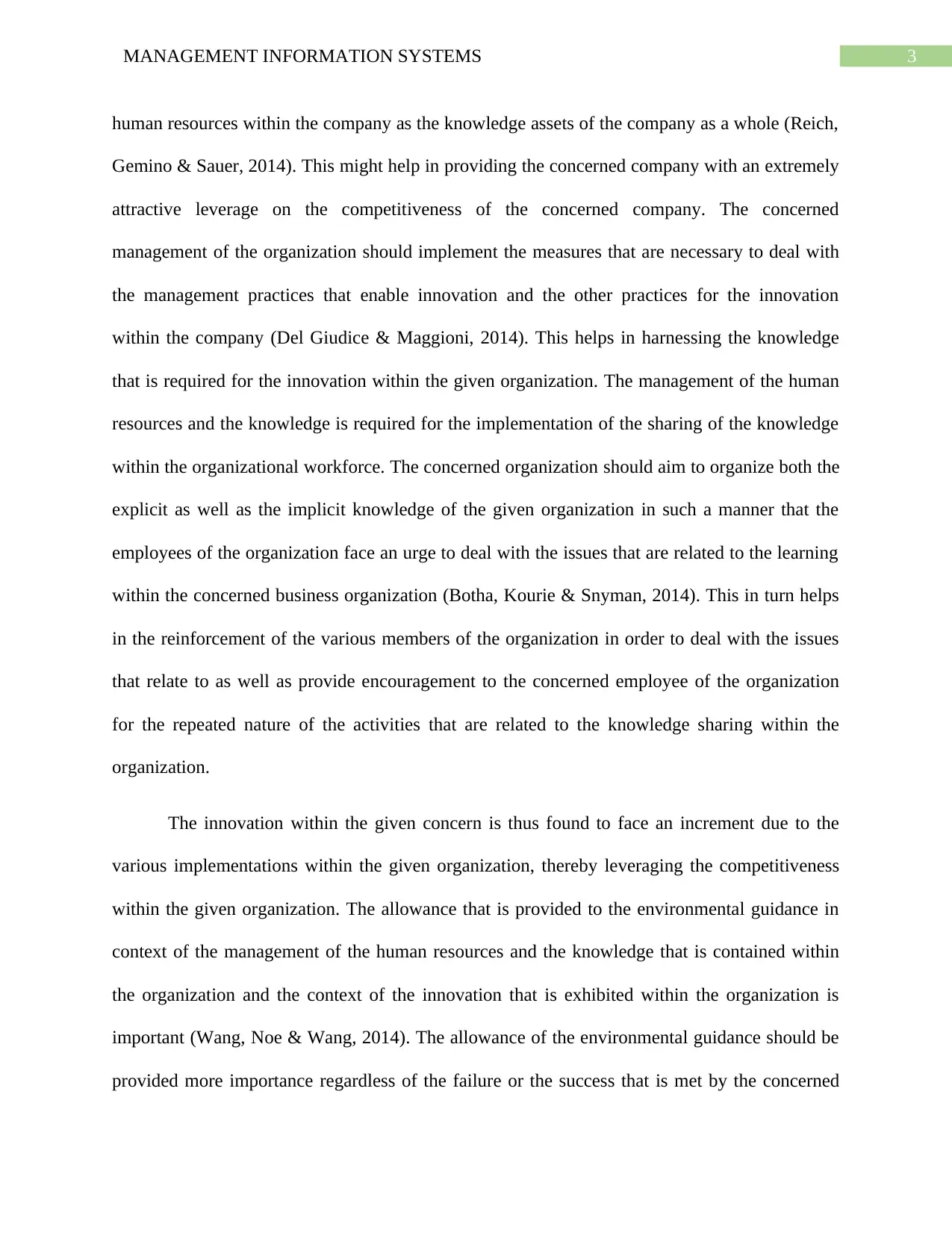
3MANAGEMENT INFORMATION SYSTEMS
human resources within the company as the knowledge assets of the company as a whole (Reich,
Gemino & Sauer, 2014). This might help in providing the concerned company with an extremely
attractive leverage on the competitiveness of the concerned company. The concerned
management of the organization should implement the measures that are necessary to deal with
the management practices that enable innovation and the other practices for the innovation
within the company (Del Giudice & Maggioni, 2014). This helps in harnessing the knowledge
that is required for the innovation within the given organization. The management of the human
resources and the knowledge is required for the implementation of the sharing of the knowledge
within the organizational workforce. The concerned organization should aim to organize both the
explicit as well as the implicit knowledge of the given organization in such a manner that the
employees of the organization face an urge to deal with the issues that are related to the learning
within the concerned business organization (Botha, Kourie & Snyman, 2014). This in turn helps
in the reinforcement of the various members of the organization in order to deal with the issues
that relate to as well as provide encouragement to the concerned employee of the organization
for the repeated nature of the activities that are related to the knowledge sharing within the
organization.
The innovation within the given concern is thus found to face an increment due to the
various implementations within the given organization, thereby leveraging the competitiveness
within the given organization. The allowance that is provided to the environmental guidance in
context of the management of the human resources and the knowledge that is contained within
the organization and the context of the innovation that is exhibited within the organization is
important (Wang, Noe & Wang, 2014). The allowance of the environmental guidance should be
provided more importance regardless of the failure or the success that is met by the concerned
human resources within the company as the knowledge assets of the company as a whole (Reich,
Gemino & Sauer, 2014). This might help in providing the concerned company with an extremely
attractive leverage on the competitiveness of the concerned company. The concerned
management of the organization should implement the measures that are necessary to deal with
the management practices that enable innovation and the other practices for the innovation
within the company (Del Giudice & Maggioni, 2014). This helps in harnessing the knowledge
that is required for the innovation within the given organization. The management of the human
resources and the knowledge is required for the implementation of the sharing of the knowledge
within the organizational workforce. The concerned organization should aim to organize both the
explicit as well as the implicit knowledge of the given organization in such a manner that the
employees of the organization face an urge to deal with the issues that are related to the learning
within the concerned business organization (Botha, Kourie & Snyman, 2014). This in turn helps
in the reinforcement of the various members of the organization in order to deal with the issues
that relate to as well as provide encouragement to the concerned employee of the organization
for the repeated nature of the activities that are related to the knowledge sharing within the
organization.
The innovation within the given concern is thus found to face an increment due to the
various implementations within the given organization, thereby leveraging the competitiveness
within the given organization. The allowance that is provided to the environmental guidance in
context of the management of the human resources and the knowledge that is contained within
the organization and the context of the innovation that is exhibited within the organization is
important (Wang, Noe & Wang, 2014). The allowance of the environmental guidance should be
provided more importance regardless of the failure or the success that is met by the concerned
Paraphrase This Document
Need a fresh take? Get an instant paraphrase of this document with our AI Paraphraser
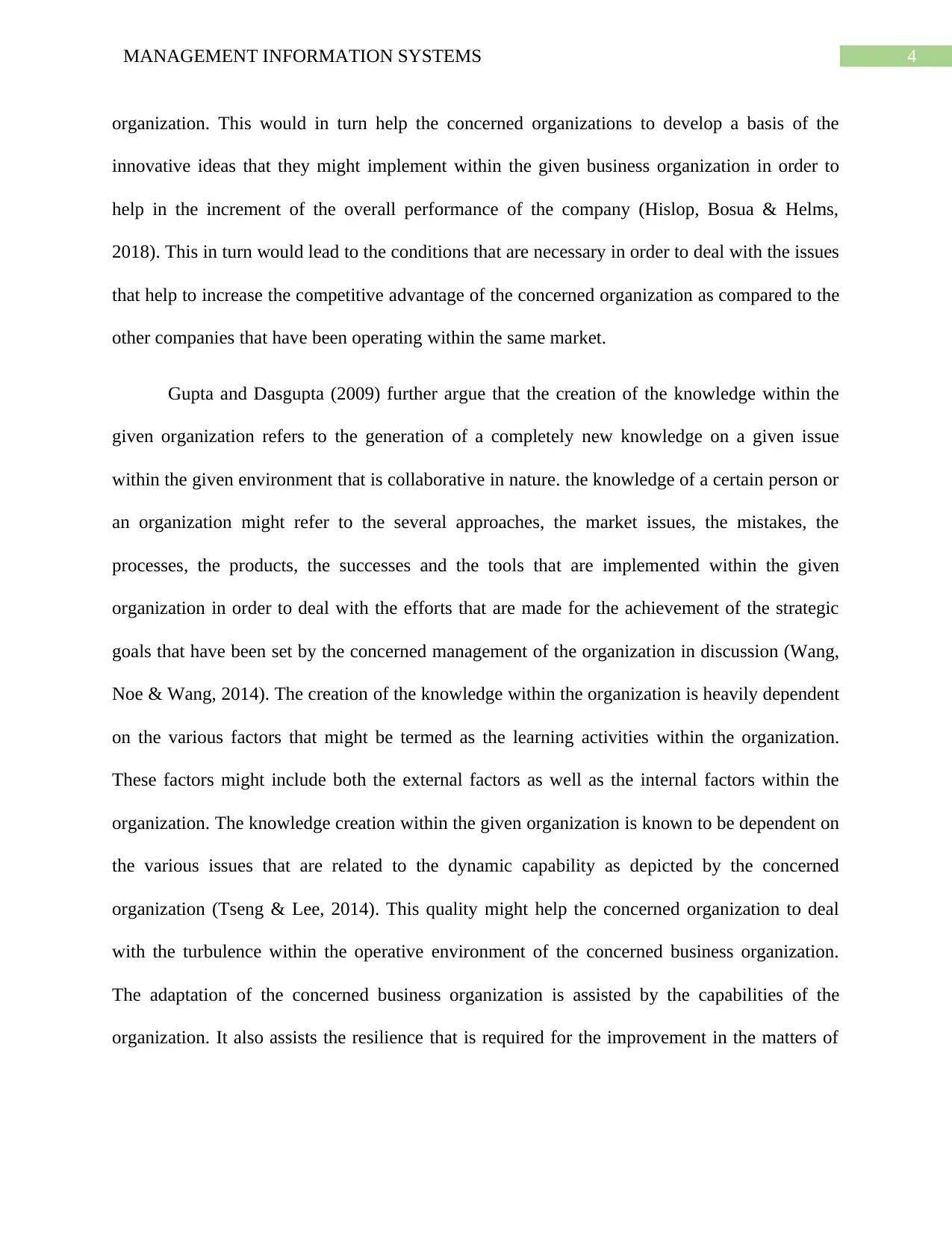
4MANAGEMENT INFORMATION SYSTEMS
organization. This would in turn help the concerned organizations to develop a basis of the
innovative ideas that they might implement within the given business organization in order to
help in the increment of the overall performance of the company (Hislop, Bosua & Helms,
2018). This in turn would lead to the conditions that are necessary in order to deal with the issues
that help to increase the competitive advantage of the concerned organization as compared to the
other companies that have been operating within the same market.
Gupta and Dasgupta (2009) further argue that the creation of the knowledge within the
given organization refers to the generation of a completely new knowledge on a given issue
within the given environment that is collaborative in nature. the knowledge of a certain person or
an organization might refer to the several approaches, the market issues, the mistakes, the
processes, the products, the successes and the tools that are implemented within the given
organization in order to deal with the efforts that are made for the achievement of the strategic
goals that have been set by the concerned management of the organization in discussion (Wang,
Noe & Wang, 2014). The creation of the knowledge within the organization is heavily dependent
on the various factors that might be termed as the learning activities within the organization.
These factors might include both the external factors as well as the internal factors within the
organization. The knowledge creation within the given organization is known to be dependent on
the various issues that are related to the dynamic capability as depicted by the concerned
organization (Tseng & Lee, 2014). This quality might help the concerned organization to deal
with the turbulence within the operative environment of the concerned business organization.
The adaptation of the concerned business organization is assisted by the capabilities of the
organization. It also assists the resilience that is required for the improvement in the matters of
organization. This would in turn help the concerned organizations to develop a basis of the
innovative ideas that they might implement within the given business organization in order to
help in the increment of the overall performance of the company (Hislop, Bosua & Helms,
2018). This in turn would lead to the conditions that are necessary in order to deal with the issues
that help to increase the competitive advantage of the concerned organization as compared to the
other companies that have been operating within the same market.
Gupta and Dasgupta (2009) further argue that the creation of the knowledge within the
given organization refers to the generation of a completely new knowledge on a given issue
within the given environment that is collaborative in nature. the knowledge of a certain person or
an organization might refer to the several approaches, the market issues, the mistakes, the
processes, the products, the successes and the tools that are implemented within the given
organization in order to deal with the efforts that are made for the achievement of the strategic
goals that have been set by the concerned management of the organization in discussion (Wang,
Noe & Wang, 2014). The creation of the knowledge within the organization is heavily dependent
on the various factors that might be termed as the learning activities within the organization.
These factors might include both the external factors as well as the internal factors within the
organization. The knowledge creation within the given organization is known to be dependent on
the various issues that are related to the dynamic capability as depicted by the concerned
organization (Tseng & Lee, 2014). This quality might help the concerned organization to deal
with the turbulence within the operative environment of the concerned business organization.
The adaptation of the concerned business organization is assisted by the capabilities of the
organization. It also assists the resilience that is required for the improvement in the matters of
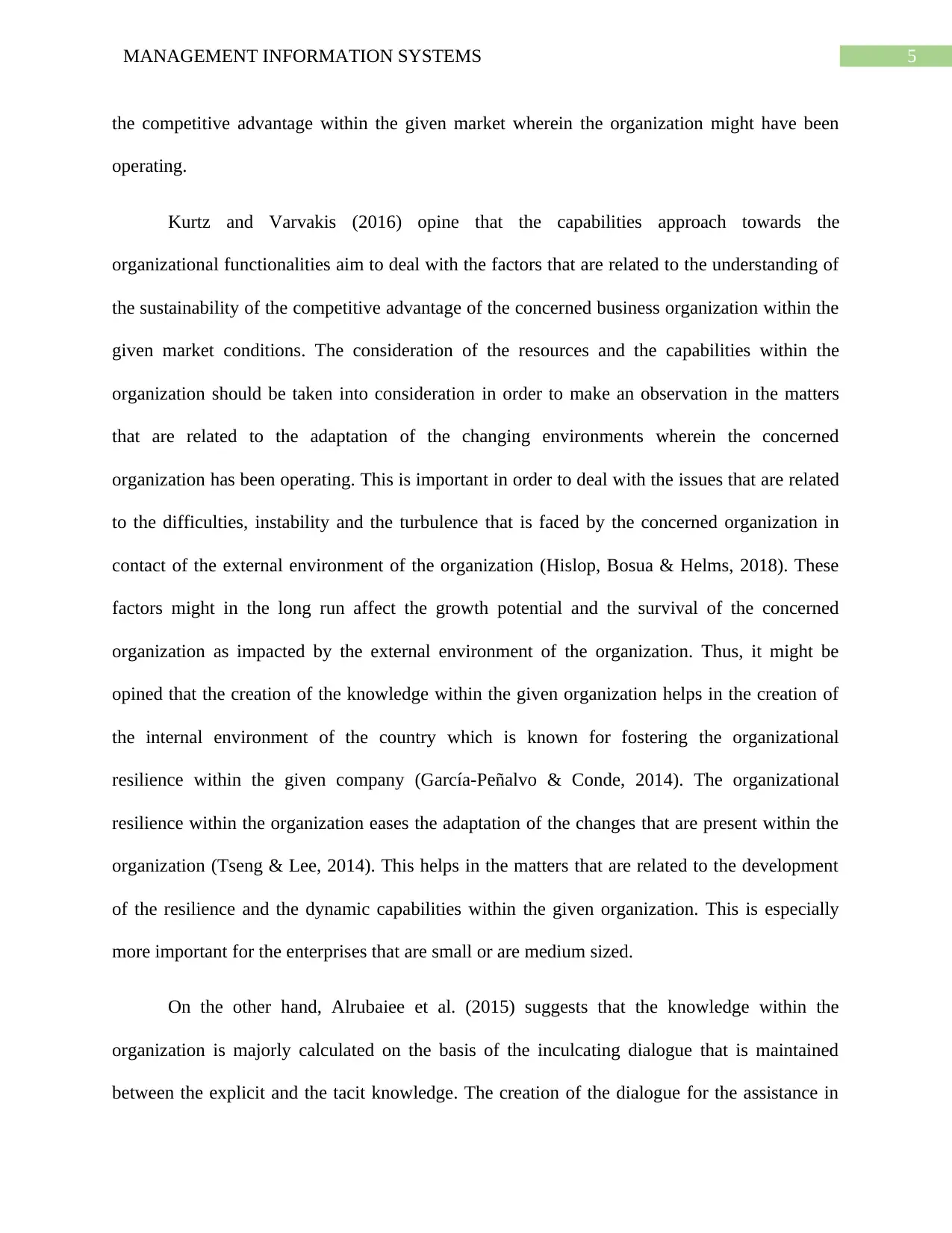
5MANAGEMENT INFORMATION SYSTEMS
the competitive advantage within the given market wherein the organization might have been
operating.
Kurtz and Varvakis (2016) opine that the capabilities approach towards the
organizational functionalities aim to deal with the factors that are related to the understanding of
the sustainability of the competitive advantage of the concerned business organization within the
given market conditions. The consideration of the resources and the capabilities within the
organization should be taken into consideration in order to make an observation in the matters
that are related to the adaptation of the changing environments wherein the concerned
organization has been operating. This is important in order to deal with the issues that are related
to the difficulties, instability and the turbulence that is faced by the concerned organization in
contact of the external environment of the organization (Hislop, Bosua & Helms, 2018). These
factors might in the long run affect the growth potential and the survival of the concerned
organization as impacted by the external environment of the organization. Thus, it might be
opined that the creation of the knowledge within the given organization helps in the creation of
the internal environment of the country which is known for fostering the organizational
resilience within the given company (García-Peñalvo & Conde, 2014). The organizational
resilience within the organization eases the adaptation of the changes that are present within the
organization (Tseng & Lee, 2014). This helps in the matters that are related to the development
of the resilience and the dynamic capabilities within the given organization. This is especially
more important for the enterprises that are small or are medium sized.
On the other hand, Alrubaiee et al. (2015) suggests that the knowledge within the
organization is majorly calculated on the basis of the inculcating dialogue that is maintained
between the explicit and the tacit knowledge. The creation of the dialogue for the assistance in
the competitive advantage within the given market wherein the organization might have been
operating.
Kurtz and Varvakis (2016) opine that the capabilities approach towards the
organizational functionalities aim to deal with the factors that are related to the understanding of
the sustainability of the competitive advantage of the concerned business organization within the
given market conditions. The consideration of the resources and the capabilities within the
organization should be taken into consideration in order to make an observation in the matters
that are related to the adaptation of the changing environments wherein the concerned
organization has been operating. This is important in order to deal with the issues that are related
to the difficulties, instability and the turbulence that is faced by the concerned organization in
contact of the external environment of the organization (Hislop, Bosua & Helms, 2018). These
factors might in the long run affect the growth potential and the survival of the concerned
organization as impacted by the external environment of the organization. Thus, it might be
opined that the creation of the knowledge within the given organization helps in the creation of
the internal environment of the country which is known for fostering the organizational
resilience within the given company (García-Peñalvo & Conde, 2014). The organizational
resilience within the organization eases the adaptation of the changes that are present within the
organization (Tseng & Lee, 2014). This helps in the matters that are related to the development
of the resilience and the dynamic capabilities within the given organization. This is especially
more important for the enterprises that are small or are medium sized.
On the other hand, Alrubaiee et al. (2015) suggests that the knowledge within the
organization is majorly calculated on the basis of the inculcating dialogue that is maintained
between the explicit and the tacit knowledge. The creation of the dialogue for the assistance in
⊘ This is a preview!⊘
Do you want full access?
Subscribe today to unlock all pages.

Trusted by 1+ million students worldwide
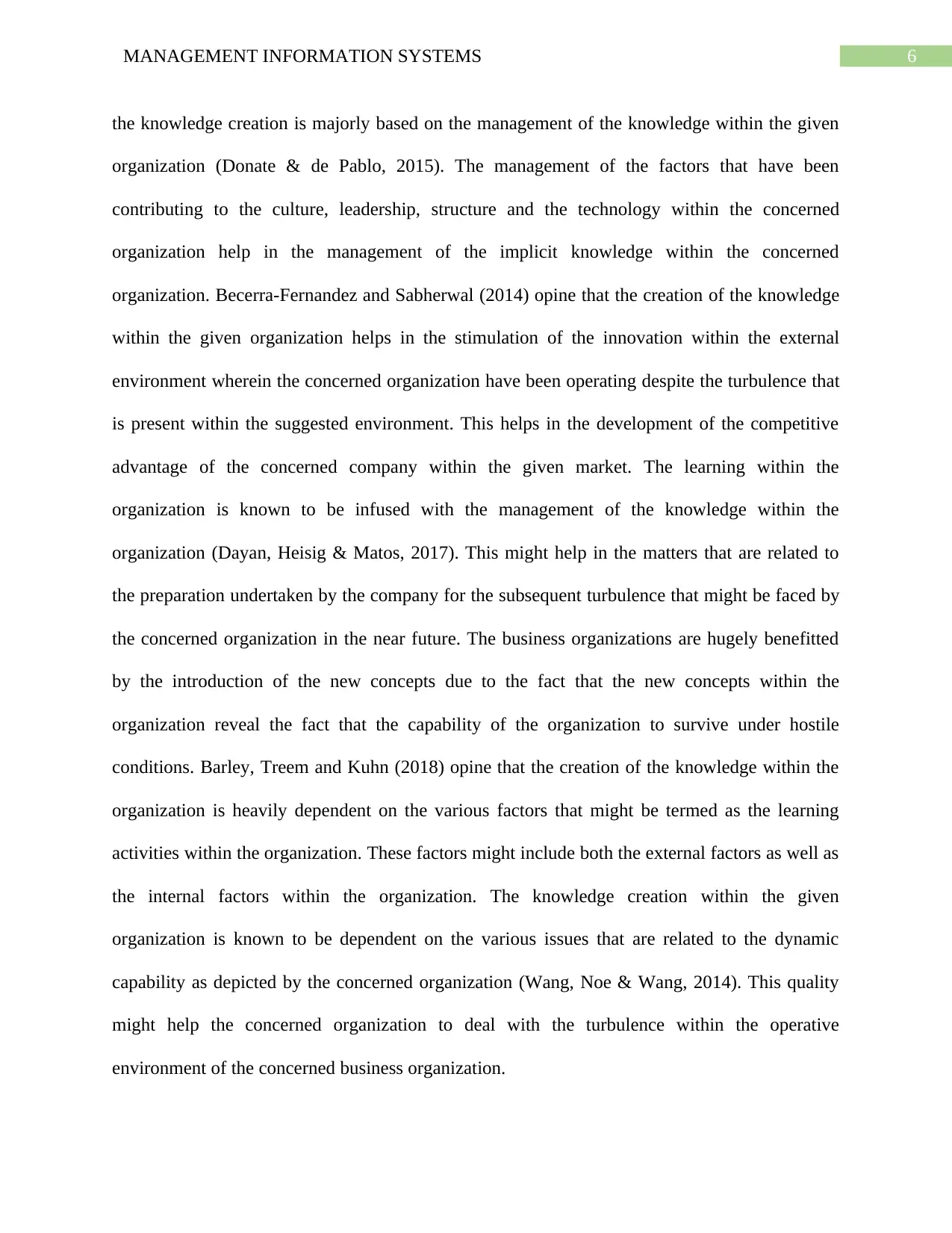
6MANAGEMENT INFORMATION SYSTEMS
the knowledge creation is majorly based on the management of the knowledge within the given
organization (Donate & de Pablo, 2015). The management of the factors that have been
contributing to the culture, leadership, structure and the technology within the concerned
organization help in the management of the implicit knowledge within the concerned
organization. Becerra-Fernandez and Sabherwal (2014) opine that the creation of the knowledge
within the given organization helps in the stimulation of the innovation within the external
environment wherein the concerned organization have been operating despite the turbulence that
is present within the suggested environment. This helps in the development of the competitive
advantage of the concerned company within the given market. The learning within the
organization is known to be infused with the management of the knowledge within the
organization (Dayan, Heisig & Matos, 2017). This might help in the matters that are related to
the preparation undertaken by the company for the subsequent turbulence that might be faced by
the concerned organization in the near future. The business organizations are hugely benefitted
by the introduction of the new concepts due to the fact that the new concepts within the
organization reveal the fact that the capability of the organization to survive under hostile
conditions. Barley, Treem and Kuhn (2018) opine that the creation of the knowledge within the
organization is heavily dependent on the various factors that might be termed as the learning
activities within the organization. These factors might include both the external factors as well as
the internal factors within the organization. The knowledge creation within the given
organization is known to be dependent on the various issues that are related to the dynamic
capability as depicted by the concerned organization (Wang, Noe & Wang, 2014). This quality
might help the concerned organization to deal with the turbulence within the operative
environment of the concerned business organization.
the knowledge creation is majorly based on the management of the knowledge within the given
organization (Donate & de Pablo, 2015). The management of the factors that have been
contributing to the culture, leadership, structure and the technology within the concerned
organization help in the management of the implicit knowledge within the concerned
organization. Becerra-Fernandez and Sabherwal (2014) opine that the creation of the knowledge
within the given organization helps in the stimulation of the innovation within the external
environment wherein the concerned organization have been operating despite the turbulence that
is present within the suggested environment. This helps in the development of the competitive
advantage of the concerned company within the given market. The learning within the
organization is known to be infused with the management of the knowledge within the
organization (Dayan, Heisig & Matos, 2017). This might help in the matters that are related to
the preparation undertaken by the company for the subsequent turbulence that might be faced by
the concerned organization in the near future. The business organizations are hugely benefitted
by the introduction of the new concepts due to the fact that the new concepts within the
organization reveal the fact that the capability of the organization to survive under hostile
conditions. Barley, Treem and Kuhn (2018) opine that the creation of the knowledge within the
organization is heavily dependent on the various factors that might be termed as the learning
activities within the organization. These factors might include both the external factors as well as
the internal factors within the organization. The knowledge creation within the given
organization is known to be dependent on the various issues that are related to the dynamic
capability as depicted by the concerned organization (Wang, Noe & Wang, 2014). This quality
might help the concerned organization to deal with the turbulence within the operative
environment of the concerned business organization.
Paraphrase This Document
Need a fresh take? Get an instant paraphrase of this document with our AI Paraphraser
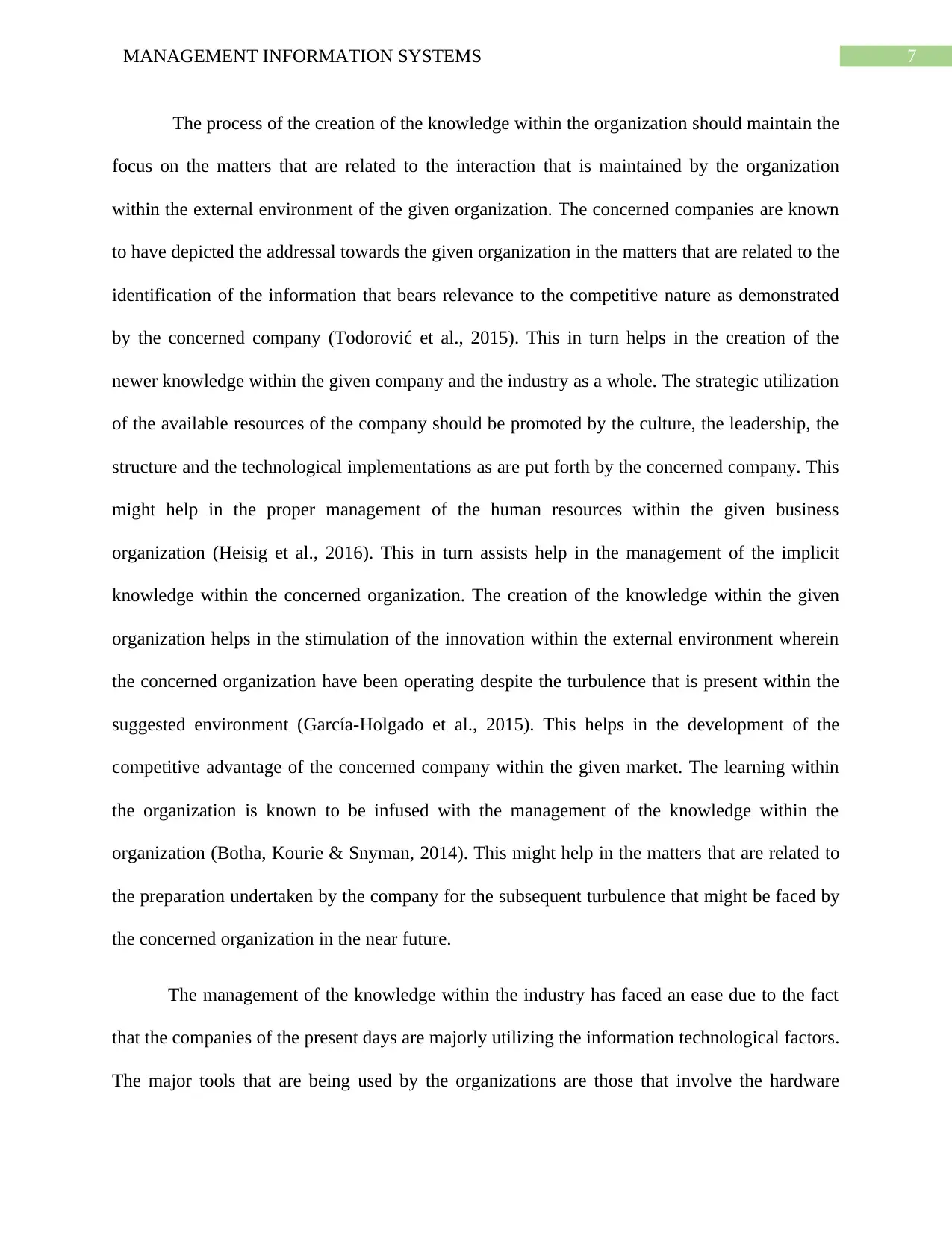
7MANAGEMENT INFORMATION SYSTEMS
The process of the creation of the knowledge within the organization should maintain the
focus on the matters that are related to the interaction that is maintained by the organization
within the external environment of the given organization. The concerned companies are known
to have depicted the addressal towards the given organization in the matters that are related to the
identification of the information that bears relevance to the competitive nature as demonstrated
by the concerned company (Todorović et al., 2015). This in turn helps in the creation of the
newer knowledge within the given company and the industry as a whole. The strategic utilization
of the available resources of the company should be promoted by the culture, the leadership, the
structure and the technological implementations as are put forth by the concerned company. This
might help in the proper management of the human resources within the given business
organization (Heisig et al., 2016). This in turn assists help in the management of the implicit
knowledge within the concerned organization. The creation of the knowledge within the given
organization helps in the stimulation of the innovation within the external environment wherein
the concerned organization have been operating despite the turbulence that is present within the
suggested environment (García-Holgado et al., 2015). This helps in the development of the
competitive advantage of the concerned company within the given market. The learning within
the organization is known to be infused with the management of the knowledge within the
organization (Botha, Kourie & Snyman, 2014). This might help in the matters that are related to
the preparation undertaken by the company for the subsequent turbulence that might be faced by
the concerned organization in the near future.
The management of the knowledge within the industry has faced an ease due to the fact
that the companies of the present days are majorly utilizing the information technological factors.
The major tools that are being used by the organizations are those that involve the hardware
The process of the creation of the knowledge within the organization should maintain the
focus on the matters that are related to the interaction that is maintained by the organization
within the external environment of the given organization. The concerned companies are known
to have depicted the addressal towards the given organization in the matters that are related to the
identification of the information that bears relevance to the competitive nature as demonstrated
by the concerned company (Todorović et al., 2015). This in turn helps in the creation of the
newer knowledge within the given company and the industry as a whole. The strategic utilization
of the available resources of the company should be promoted by the culture, the leadership, the
structure and the technological implementations as are put forth by the concerned company. This
might help in the proper management of the human resources within the given business
organization (Heisig et al., 2016). This in turn assists help in the management of the implicit
knowledge within the concerned organization. The creation of the knowledge within the given
organization helps in the stimulation of the innovation within the external environment wherein
the concerned organization have been operating despite the turbulence that is present within the
suggested environment (García-Holgado et al., 2015). This helps in the development of the
competitive advantage of the concerned company within the given market. The learning within
the organization is known to be infused with the management of the knowledge within the
organization (Botha, Kourie & Snyman, 2014). This might help in the matters that are related to
the preparation undertaken by the company for the subsequent turbulence that might be faced by
the concerned organization in the near future.
The management of the knowledge within the industry has faced an ease due to the fact
that the companies of the present days are majorly utilizing the information technological factors.
The major tools that are being used by the organizations are those that involve the hardware
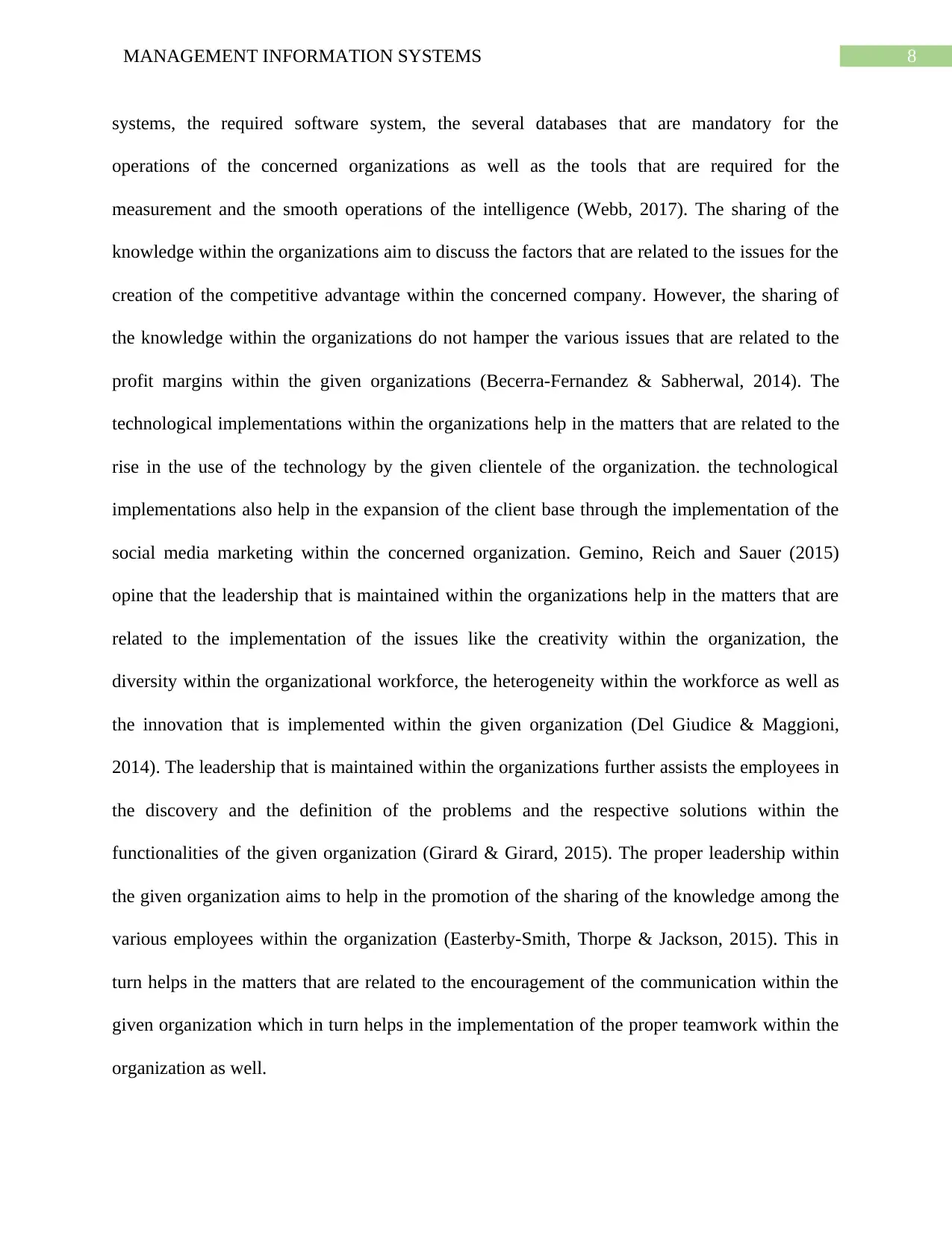
8MANAGEMENT INFORMATION SYSTEMS
systems, the required software system, the several databases that are mandatory for the
operations of the concerned organizations as well as the tools that are required for the
measurement and the smooth operations of the intelligence (Webb, 2017). The sharing of the
knowledge within the organizations aim to discuss the factors that are related to the issues for the
creation of the competitive advantage within the concerned company. However, the sharing of
the knowledge within the organizations do not hamper the various issues that are related to the
profit margins within the given organizations (Becerra-Fernandez & Sabherwal, 2014). The
technological implementations within the organizations help in the matters that are related to the
rise in the use of the technology by the given clientele of the organization. the technological
implementations also help in the expansion of the client base through the implementation of the
social media marketing within the concerned organization. Gemino, Reich and Sauer (2015)
opine that the leadership that is maintained within the organizations help in the matters that are
related to the implementation of the issues like the creativity within the organization, the
diversity within the organizational workforce, the heterogeneity within the workforce as well as
the innovation that is implemented within the given organization (Del Giudice & Maggioni,
2014). The leadership that is maintained within the organizations further assists the employees in
the discovery and the definition of the problems and the respective solutions within the
functionalities of the given organization (Girard & Girard, 2015). The proper leadership within
the given organization aims to help in the promotion of the sharing of the knowledge among the
various employees within the organization (Easterby-Smith, Thorpe & Jackson, 2015). This in
turn helps in the matters that are related to the encouragement of the communication within the
given organization which in turn helps in the implementation of the proper teamwork within the
organization as well.
systems, the required software system, the several databases that are mandatory for the
operations of the concerned organizations as well as the tools that are required for the
measurement and the smooth operations of the intelligence (Webb, 2017). The sharing of the
knowledge within the organizations aim to discuss the factors that are related to the issues for the
creation of the competitive advantage within the concerned company. However, the sharing of
the knowledge within the organizations do not hamper the various issues that are related to the
profit margins within the given organizations (Becerra-Fernandez & Sabherwal, 2014). The
technological implementations within the organizations help in the matters that are related to the
rise in the use of the technology by the given clientele of the organization. the technological
implementations also help in the expansion of the client base through the implementation of the
social media marketing within the concerned organization. Gemino, Reich and Sauer (2015)
opine that the leadership that is maintained within the organizations help in the matters that are
related to the implementation of the issues like the creativity within the organization, the
diversity within the organizational workforce, the heterogeneity within the workforce as well as
the innovation that is implemented within the given organization (Del Giudice & Maggioni,
2014). The leadership that is maintained within the organizations further assists the employees in
the discovery and the definition of the problems and the respective solutions within the
functionalities of the given organization (Girard & Girard, 2015). The proper leadership within
the given organization aims to help in the promotion of the sharing of the knowledge among the
various employees within the organization (Easterby-Smith, Thorpe & Jackson, 2015). This in
turn helps in the matters that are related to the encouragement of the communication within the
given organization which in turn helps in the implementation of the proper teamwork within the
organization as well.
⊘ This is a preview!⊘
Do you want full access?
Subscribe today to unlock all pages.

Trusted by 1+ million students worldwide
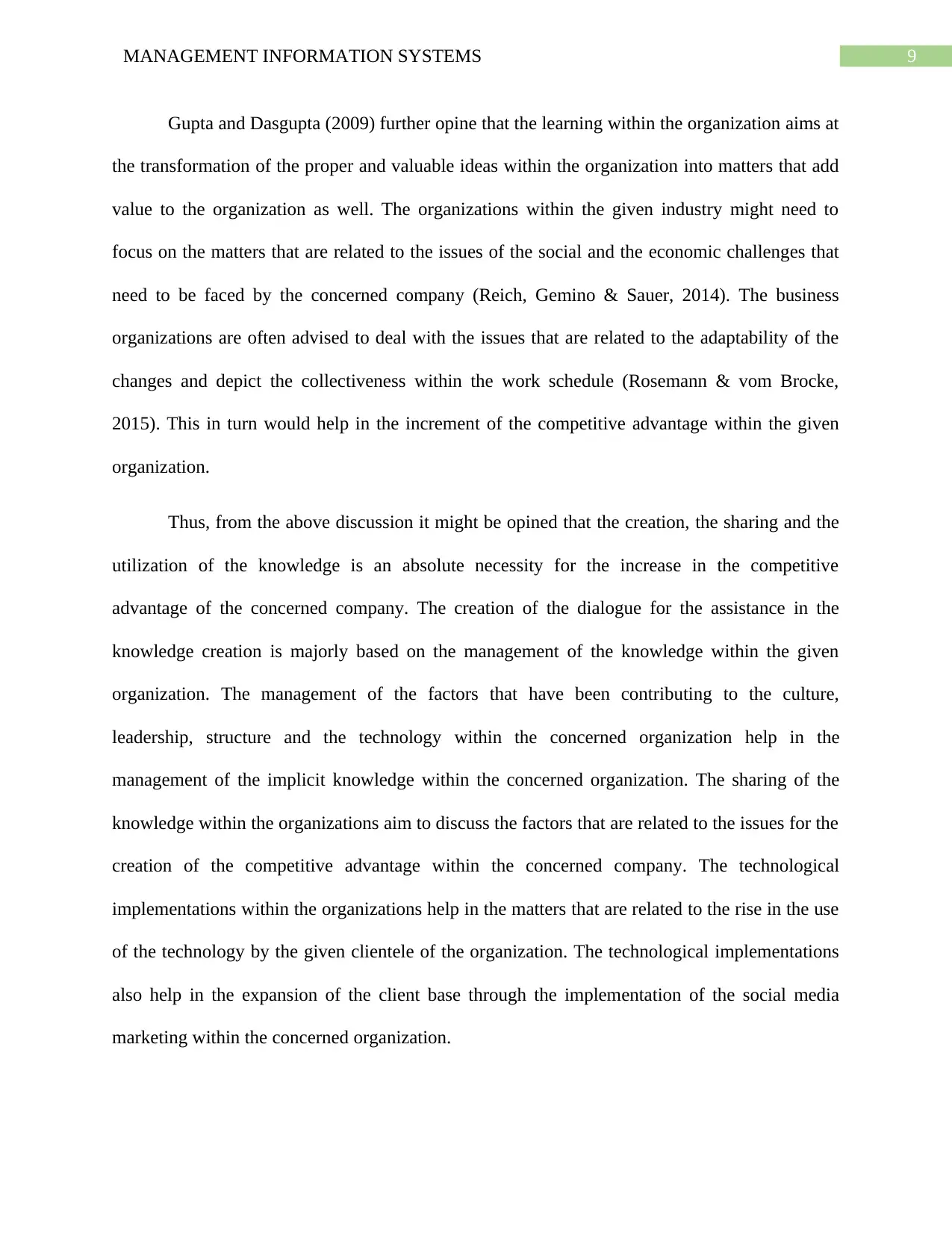
9MANAGEMENT INFORMATION SYSTEMS
Gupta and Dasgupta (2009) further opine that the learning within the organization aims at
the transformation of the proper and valuable ideas within the organization into matters that add
value to the organization as well. The organizations within the given industry might need to
focus on the matters that are related to the issues of the social and the economic challenges that
need to be faced by the concerned company (Reich, Gemino & Sauer, 2014). The business
organizations are often advised to deal with the issues that are related to the adaptability of the
changes and depict the collectiveness within the work schedule (Rosemann & vom Brocke,
2015). This in turn would help in the increment of the competitive advantage within the given
organization.
Thus, from the above discussion it might be opined that the creation, the sharing and the
utilization of the knowledge is an absolute necessity for the increase in the competitive
advantage of the concerned company. The creation of the dialogue for the assistance in the
knowledge creation is majorly based on the management of the knowledge within the given
organization. The management of the factors that have been contributing to the culture,
leadership, structure and the technology within the concerned organization help in the
management of the implicit knowledge within the concerned organization. The sharing of the
knowledge within the organizations aim to discuss the factors that are related to the issues for the
creation of the competitive advantage within the concerned company. The technological
implementations within the organizations help in the matters that are related to the rise in the use
of the technology by the given clientele of the organization. The technological implementations
also help in the expansion of the client base through the implementation of the social media
marketing within the concerned organization.
Gupta and Dasgupta (2009) further opine that the learning within the organization aims at
the transformation of the proper and valuable ideas within the organization into matters that add
value to the organization as well. The organizations within the given industry might need to
focus on the matters that are related to the issues of the social and the economic challenges that
need to be faced by the concerned company (Reich, Gemino & Sauer, 2014). The business
organizations are often advised to deal with the issues that are related to the adaptability of the
changes and depict the collectiveness within the work schedule (Rosemann & vom Brocke,
2015). This in turn would help in the increment of the competitive advantage within the given
organization.
Thus, from the above discussion it might be opined that the creation, the sharing and the
utilization of the knowledge is an absolute necessity for the increase in the competitive
advantage of the concerned company. The creation of the dialogue for the assistance in the
knowledge creation is majorly based on the management of the knowledge within the given
organization. The management of the factors that have been contributing to the culture,
leadership, structure and the technology within the concerned organization help in the
management of the implicit knowledge within the concerned organization. The sharing of the
knowledge within the organizations aim to discuss the factors that are related to the issues for the
creation of the competitive advantage within the concerned company. The technological
implementations within the organizations help in the matters that are related to the rise in the use
of the technology by the given clientele of the organization. The technological implementations
also help in the expansion of the client base through the implementation of the social media
marketing within the concerned organization.
Paraphrase This Document
Need a fresh take? Get an instant paraphrase of this document with our AI Paraphraser
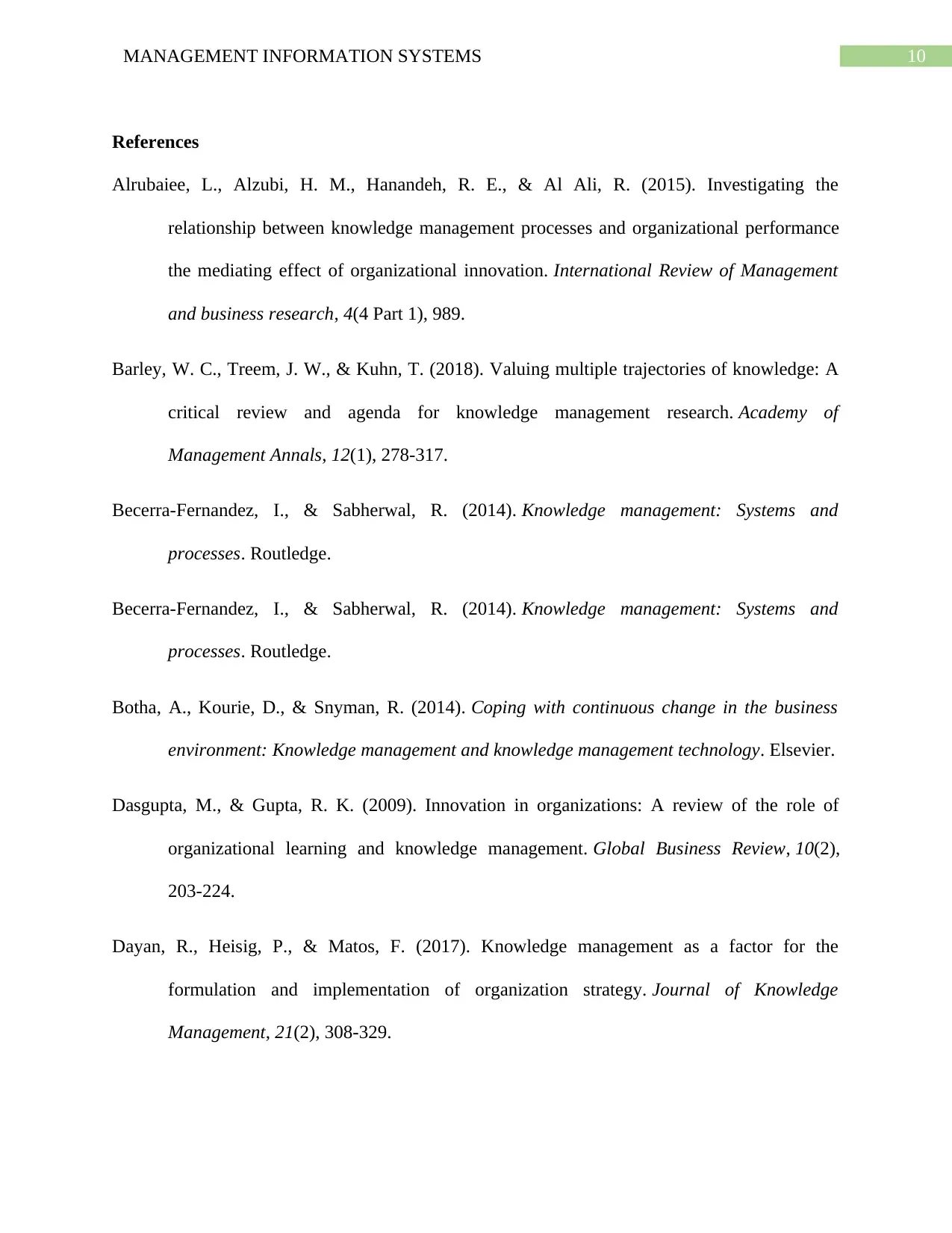
10MANAGEMENT INFORMATION SYSTEMS
References
Alrubaiee, L., Alzubi, H. M., Hanandeh, R. E., & Al Ali, R. (2015). Investigating the
relationship between knowledge management processes and organizational performance
the mediating effect of organizational innovation. International Review of Management
and business research, 4(4 Part 1), 989.
Barley, W. C., Treem, J. W., & Kuhn, T. (2018). Valuing multiple trajectories of knowledge: A
critical review and agenda for knowledge management research. Academy of
Management Annals, 12(1), 278-317.
Becerra-Fernandez, I., & Sabherwal, R. (2014). Knowledge management: Systems and
processes. Routledge.
Becerra-Fernandez, I., & Sabherwal, R. (2014). Knowledge management: Systems and
processes. Routledge.
Botha, A., Kourie, D., & Snyman, R. (2014). Coping with continuous change in the business
environment: Knowledge management and knowledge management technology. Elsevier.
Dasgupta, M., & Gupta, R. K. (2009). Innovation in organizations: A review of the role of
organizational learning and knowledge management. Global Business Review, 10(2),
203-224.
Dayan, R., Heisig, P., & Matos, F. (2017). Knowledge management as a factor for the
formulation and implementation of organization strategy. Journal of Knowledge
Management, 21(2), 308-329.
References
Alrubaiee, L., Alzubi, H. M., Hanandeh, R. E., & Al Ali, R. (2015). Investigating the
relationship between knowledge management processes and organizational performance
the mediating effect of organizational innovation. International Review of Management
and business research, 4(4 Part 1), 989.
Barley, W. C., Treem, J. W., & Kuhn, T. (2018). Valuing multiple trajectories of knowledge: A
critical review and agenda for knowledge management research. Academy of
Management Annals, 12(1), 278-317.
Becerra-Fernandez, I., & Sabherwal, R. (2014). Knowledge management: Systems and
processes. Routledge.
Becerra-Fernandez, I., & Sabherwal, R. (2014). Knowledge management: Systems and
processes. Routledge.
Botha, A., Kourie, D., & Snyman, R. (2014). Coping with continuous change in the business
environment: Knowledge management and knowledge management technology. Elsevier.
Dasgupta, M., & Gupta, R. K. (2009). Innovation in organizations: A review of the role of
organizational learning and knowledge management. Global Business Review, 10(2),
203-224.
Dayan, R., Heisig, P., & Matos, F. (2017). Knowledge management as a factor for the
formulation and implementation of organization strategy. Journal of Knowledge
Management, 21(2), 308-329.
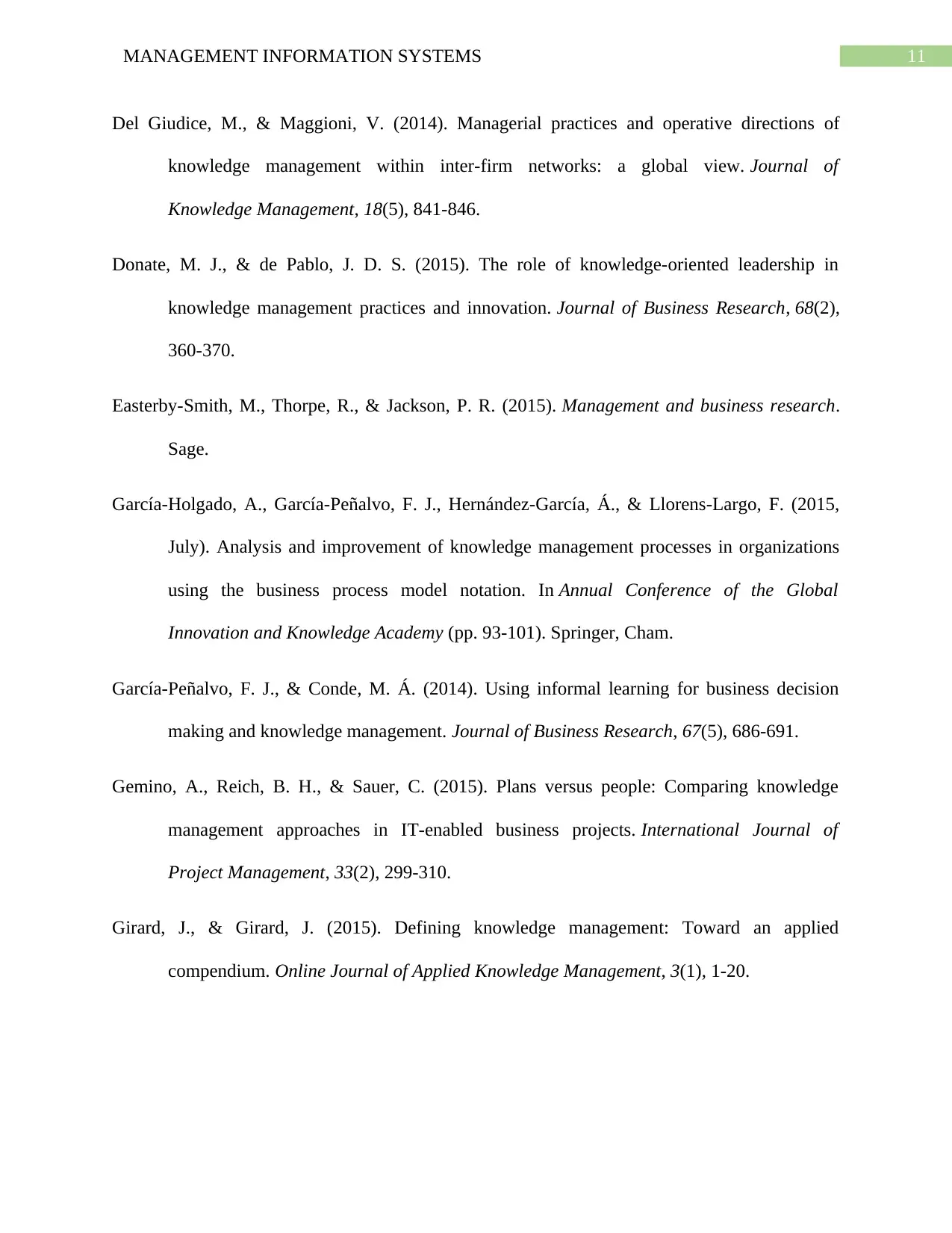
11MANAGEMENT INFORMATION SYSTEMS
Del Giudice, M., & Maggioni, V. (2014). Managerial practices and operative directions of
knowledge management within inter-firm networks: a global view. Journal of
Knowledge Management, 18(5), 841-846.
Donate, M. J., & de Pablo, J. D. S. (2015). The role of knowledge-oriented leadership in
knowledge management practices and innovation. Journal of Business Research, 68(2),
360-370.
Easterby-Smith, M., Thorpe, R., & Jackson, P. R. (2015). Management and business research.
Sage.
García-Holgado, A., García-Peñalvo, F. J., Hernández-García, Á., & Llorens-Largo, F. (2015,
July). Analysis and improvement of knowledge management processes in organizations
using the business process model notation. In Annual Conference of the Global
Innovation and Knowledge Academy (pp. 93-101). Springer, Cham.
García-Peñalvo, F. J., & Conde, M. Á. (2014). Using informal learning for business decision
making and knowledge management. Journal of Business Research, 67(5), 686-691.
Gemino, A., Reich, B. H., & Sauer, C. (2015). Plans versus people: Comparing knowledge
management approaches in IT-enabled business projects. International Journal of
Project Management, 33(2), 299-310.
Girard, J., & Girard, J. (2015). Defining knowledge management: Toward an applied
compendium. Online Journal of Applied Knowledge Management, 3(1), 1-20.
Del Giudice, M., & Maggioni, V. (2014). Managerial practices and operative directions of
knowledge management within inter-firm networks: a global view. Journal of
Knowledge Management, 18(5), 841-846.
Donate, M. J., & de Pablo, J. D. S. (2015). The role of knowledge-oriented leadership in
knowledge management practices and innovation. Journal of Business Research, 68(2),
360-370.
Easterby-Smith, M., Thorpe, R., & Jackson, P. R. (2015). Management and business research.
Sage.
García-Holgado, A., García-Peñalvo, F. J., Hernández-García, Á., & Llorens-Largo, F. (2015,
July). Analysis and improvement of knowledge management processes in organizations
using the business process model notation. In Annual Conference of the Global
Innovation and Knowledge Academy (pp. 93-101). Springer, Cham.
García-Peñalvo, F. J., & Conde, M. Á. (2014). Using informal learning for business decision
making and knowledge management. Journal of Business Research, 67(5), 686-691.
Gemino, A., Reich, B. H., & Sauer, C. (2015). Plans versus people: Comparing knowledge
management approaches in IT-enabled business projects. International Journal of
Project Management, 33(2), 299-310.
Girard, J., & Girard, J. (2015). Defining knowledge management: Toward an applied
compendium. Online Journal of Applied Knowledge Management, 3(1), 1-20.
⊘ This is a preview!⊘
Do you want full access?
Subscribe today to unlock all pages.

Trusted by 1+ million students worldwide
1 out of 14
Related Documents
Your All-in-One AI-Powered Toolkit for Academic Success.
+13062052269
info@desklib.com
Available 24*7 on WhatsApp / Email
![[object Object]](/_next/static/media/star-bottom.7253800d.svg)
Unlock your academic potential
Copyright © 2020–2025 A2Z Services. All Rights Reserved. Developed and managed by ZUCOL.





